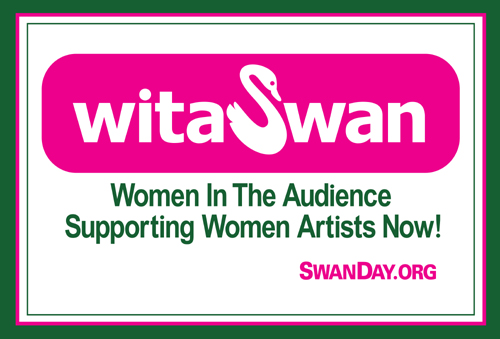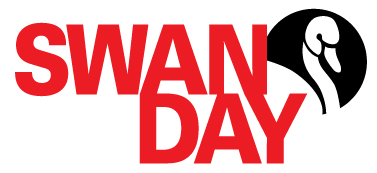
The 7th International SWAN Day is Saturday, March
29, 2014.
Click HERE for details
J
(Note that 3/30/13 is the "official date," but please feel free to celebrate any date in March or April that is most convenient for you. The spirit of SWAN events is far more important than the exact date.)
What is WITASWAN?
WITASWAN (“wit-uh-swan”) is an Internet initiative, a grass roots movement, a cause—not an organization. It is an informal alliance of women who use their power as consumers to increase opportunities for women artists. There are no dues, no meetings or committees, and no specific fundraising drives.
As the creative force behind the WITASWAN initiative, Jan Lisa Huttner’s goal is to help women make more deliberate decisions when they go out to see movies in theatres, and when they rent or purchase movies on DVD. She wants women to ask themselves what they are selecting and why. Her ardent conviction is that once women begin to see themselves as intelligent movie consumers, they will start selecting more films by women filmmakers.
Jan wants women to realize that every time a woman purchases theatre tickets and/or acquires DVDs or watches a movie online, her action has enormous economic consequences. The revenue generated (or not generated) by films directed by women affects future options for that director as well as all the women on her team (in front of the camera as well as behind it).
WITASWAN members make a commitment to see at least one film every month that is directed or written by a woman, whether it is in a theater, on a DVD, or online. Often women take the pledge with friends (male AND female), so they can discuss the films they see.
How did WITASWAN start?
WITASWAN began one fateful Sunday on June 2, 2002, when Jan read an article by Dana Kennedy in The New York Times.
Kennedy had quoted a study from San Diego State University called
“The Celluloid Ceiling,” in which Professor Martha Lauzen reported that little had changed for women filmmakers in the years since she had been counting. In 1987, women directed only three of the 100 highest-grossing films. By 2001, Lauzen reported that number had only risen to four. As Jan fixated on the quotes from Lauzen in Kennedy’s article, her lifetime of feminist activism began to coalesce into a single point of focus.
Jan wrote a letter to The New York Times and sent a copy of it in an e-mail message to Professor Lauzen. The NYT editors published her letter, and Jan followed up by interviewing Lauzen. To this day, this interview
(posted on FF2 on
8/15/03) continues to be one of the longest, most comprehensive interviews anyone has ever done with Lauzen, even to this day.
Linda Henning Cohen, then Program Vice President the Illinois division of the American Association of University Women (aka
AAUW-Illinois), asked Jan to present a workshop about “The Celluloid Ceiling” at the 2003 Spring Convention. Forty-two people attended a showing of A JURY OF HER PEERS followed by a discussion with filmmaker Sally Heckel. As a result, AAUW-Illinois branches all around the state began inviting Jan to bring JURY to their local branches. JURY was not commercially available at that time, but thanks to the members of AAUW-Illinois, it is now available on DVD from
Women Make
Movies.
In 2004, the AAUW-Illinois Board of Directors decided to create an “incubator” for this new project. After much discussion, they decided to call the project WITASWAN
(Women in the Audience Supporting Women
Artist Now!). In 2005, members of AAUW-Illinois, in collaboration with the Chicago Area Women’s History Council, the Illinois Woman’s Press Association, and Women in Director’s Chair, showed A JURY OF HER PEERS at the Chicago Cultural Center. The
event was a huge success and WITASWAN began to take on steam!
How did Jan meet Martha Richards?
It all started with a phone call in 2005… In 2005, Jan received a phone call from Martha Richards.
It was a natural alliance. Richards had built
the WomenArts
Network, an online directory of more than 1,000 women artists from all over the world. Jan had demonstrated through her work with WITASWAN that there were women audience members who wanted to see more work by women. These two dynamic women began working together.
WomenArts, incorporated as the Fund for Women Artists, is a nonprofit 501(c)(3) created by Richards in 1994 as a worldwide community of artists and allies that works for empowerment, opportunity, and visibility for women artists. The
WomenArts Network provides a variety of free online networking, fundraising, and advocacy services.
Richards and WomenArts believe in the power of women artists to create, connect, and change the world.
International SWAN Day, and the other programs of WomenArts, are made possible by generous grants from the National Endowment for the Arts, the Nathan Cummings Foundation, the Meyer Levy Charitable Foundation, the Peace Development Fund, the Gratitude Fund of the East Bay Community Foundation, the Leo S. Guthman Fund, and The Sister Fund, as well as by gifts of time, energy and money from artists and arts supporters around the world. Jan and husband Rich have also made substantial annual donations to WomenArts in honor of their mothers: Helene Huttner and Juanita Miller.
The Birth of International SWAN Day
On Jan’s recommendation, AAUW-Illinois’ new Program Vice President Lois Strom invited Martha to speak at the 2007 Spring Convention in Bloomington.
The idea for International SWAN Day was born during the ride back from Bloomington to Chicago, when Jan and Martha stopped on the road for pizza. As they ways to build more direct connections between women artists and women audience members, Jan and Martha envisioned SWAN Day as a galvanizing annual event that could serve both artists and audience members all around the world.
Click HERE for more details of this historic meeting (including many photos).
2008: The First International SWAN Day
In June of 2007, Jan and Richards jointly announced their plan to celebrate
“International SWAN Day” on March 29, 2008 (the last Saturday of March). Why March? Because March is Women’s History Month, a perfect time to bring women artists and filmmakers into the public spotlight — and to show that women in the audience have untapped box office power.
On International SWAN Day 2011 — only four years after it launched — WomenArts and WITASWAN, working together, provided encouragement and collateral materials for more than 700 events all around the world, including Argentina, Australia, Bosnia-Herzegovina, Bulgaria, Canada, China, Croatia, France, Germany, Ghana, India, Indonesia, Israel, Italy, Jamaica, Kenya, Philippines, Romania, Uruguay, Wales/U.K., and, of course, the USA.
That year, seven hundred people celebrated “SWAN Day Kenya” in Nairobi. In Bulgaria, they celebrated with a five-day theater festival.
Why is International SWAN Day so important?
International SWAN Day celebrations enable women to see that they have the power to inspire and strengthen each other. WomenArts has done video interviews with television star Sandra Oh, novelist Isabel Allende, and film star Famke Janssen, asking them to talk about the women artists who have inspired them. Sandra Oh said that the musician Bjork inspired her with her courage. Isabel Allende said that the early women’s movement writers showed her a new way to think about her life. Famke Janssen said that she was fascinated by the way Louise Bourgeois’ sculptures were able to capture so many layers of meaning all at once. Each of these talented artists said that her own work was deepened by the work of other women artists.
Isabel Allende went even further. When WomenArts asked her if she had advice for women artists, she said that the key to survival is to “Be connected – even if you are living in terrible circumstances, if you can connect with other women, you can feel the energy, you feel the force, you are not alone.”
While many organizations are doing excellent work for women artists within their own disciplines and their own countries, SWAN Day is different — it is both international in focus and more comprehensive in design. SWAN Day is also an example of how a movement of women artists can be much more powerful by joining together across disciplines and across borders with women in the audience.
Since the first International SWAN Day in 2008, thousands of artists and audience members have gathered on the last Saturday of March to focus attention on the work of women artists, and to help people imagine what the world might be like if women’s art and perspectives were fully integrated into all of our lives.
International SWAN Day celebrations include national, regional, and local gatherings of women of all ages — at performances, exhibits, rallies, parades, auctions, and a variety of other activities designed to celebrate women artists. Sometimes they also raise money for women artists who live and work in their communities. The long-term goal of this holiday is to inspire communities around the world to find new ways to recognize and support women artists as a basic element of civic planning.
Everyone can participate in International SWAN Day!
International SWAN Day is a collaborative grassroots effort that is coordinated by WITASWAN and WomenArts through the WomanArts website. Everyone is invited to help us celebrate this unique annual holiday.
No fees or application forms are required. Just add a link to WomenArts, credit us for use of our collateral materials (logos, etc) and be creative.
There are so many ways to participate!
First look for International SWAN Day activities already scheduled in your own community, and if you can go, then go!
Also consider hosting a SWAN Day Party by gathering friends at your house to watch a film by a woman filmmaker on DVD, and then talk about ways that you might help the women artists in your community.
Invite local artists to speak at the Party. Introduce students to women artists from the USA and other countries! Teachers and college professors who would like to introduce their students to women artists may contact WomenArts. WomenArts is especially interested in organizing international pen-pal or exchange programs.
Wear SWAN Shirts, Jewelry and Other Items. When anyone asks you, tell them you are wearing swans because you want to see more art reflecting women's perspectives. These casual conversations are a great way to make people more aware of the discrimination faced by women artists.
Visit the WomanArts Store where you can purchase pins, t-shirts, hats, and totebags, as well as mugs, magnets, and notebooks (with you choice of International SWAN Day, WITASWAN & WomenArts designs).

